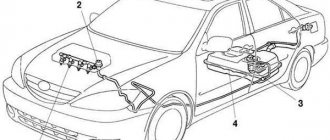Yuri Vetrov dealt with the true orientation of the new generation Toyota RAV4 crossover
Toyota likes to repeat that 19 years ago, it was the RAV4 that became the world's first compact crossover - all-wheel drive, with high ground clearance, a monocoque body, independent suspension and units from a passenger car. This is true. Unless, of course, we remember our Niva model of 1976 (weeded out on formal grounds due to the continuous rear axle) and the Suzuki Escudo (aka Vitara) of 1988 - it had a frame design.
The first 12 years for “Rafik” were cloudless. Even in 2006, when the Tiguan, Qashqai and Kuga had yet to see the light of day, the RAV4 held 22% of the European market. And now - only seven percent! Ahead are the Qashqai (24%), the Korean couple ix35/Sportage (20% between them) and even the Tiguan (13%). On an equal footing with the Rafik are the Mitsubishi ASX and Ford Kuga, which each captured 7% of the European market...
So the task of the new “Rafik” is not to regain the lost leadership, but at least to stay in the general flow.
The new language of Toyota design is Knee look (in the interpretation of the Russian office of Toyota - “Strict look”) and Under priority (“Emphasis on the lower part”). True, it’s worth driving out of the thickets onto the asphalt - and the body, raised for the sake of 20-centimeter ground clearance, plus relatively modest 17-inch wheels, involuntarily suggests thoughts of a colossus with feet of clay. Or will it be suitable for undemanding men? Or maybe the expectation is that the stronger half of humanity will be pleased with the horizontal part of the rear lights, on which you can safely place five sandwiches and the same number of glasses during a roadside picnic?
The instruments have become simpler: the coolant temperature indicator has disappeared, and the pleasant orange backlight has been replaced by poisonous blue
It's the same story inside. Smooth and flat, like a table, the front panel gives rise to exclusively “dining” associations. And a simple open shelf instead of an upper glove compartment with a lid is unlikely to upset those who do not keep a bunch of rags and napkins on hand. Rather, it will please you - the interior looks fresh with it. The eyes only protest against the “Clear blue” club lighting of everything.
Fit men will also like a more sporty fit. You don’t immediately notice that the seat is installed 5 mm lower than before, and the tilt of the steering column has become 2.3 degrees closer to horizontal. But the tight embrace of the relief chairs is impossible not to notice.
By the way, is this RAV4 really that new? I asked myself a similar question whenever engineers said that “body rigidity has been increased by 3% due to more weld points at the bottom of the door openings” or “reinforced front and rear suspension subframes have improved steering response.”
Unlike the Honda CR-V, at Toyota the matter was not limited to deep restyling: the “top” of the body is indeed new. But here’s the “bottom”... The same units, the same wheelbase - yes, this is a modernized long-wheelbase RAV4 of the previous generation! “By covering their tracks,” the Japanese confused even Igor Vladimirsky, who attended the “static” presentation in Brussels. In fact, the RAV4 is 80 mm shorter than Igor indicated: 4570 mm, the difference with the Honda CR-V is only a millimeter.
Using the Sport button, you can invigorate not only the automatic transmission, but also the electronics that control the distribution of traction along the axles. If in standard mode it supplies a maximum of 30% of torque to the rear wheels in the middle of a turn, then in sports mode it delivers up to 50%. The electronics operating strategy will also be different when entering an arc: Sport mode involves transferring 10% of traction to the rear wheels, which reduces the tendency to drift
Using the Sport button, you can invigorate not only the automatic transmission, but also the electronics that control the distribution of traction along the axles. If in standard mode it supplies a maximum of 30% of torque to the rear wheels in the middle of a turn, then in sports mode it delivers up to 50%. The electronics operating strategy will also be different when entering an arc: Sport mode involves transferring 10% of traction to the rear wheels, which reduces the tendency to drift
0 / 0
If the dimensions of the versions for America, China, Europe and Russia do not differ, then the dimensions of the trunk differ significantly. Because we Russians are entitled to a full-size spare wheel. In gratitude for this, we will accept the fact that the 100-liter underground has shrunk to two small drawers, and the volume of the entire trunk has decreased by 7.5% - from 547 to 506 liters. Moreover, previously the long-wheelbase version (the one with a spare tire inside the cabin) still had a more modest trunk - 410 liters. But at the same time, the engineers still managed to increase the distance from the gas pedal to the back of the rear seat by seven centimeters: it became even more comfortable for passengers!
The only thing I'm not delighted with is the new approach to transforming the interior. Toyota, as if following the example of Honda or Mitsubishi, abandoned both the ski hatch and the longitudinal adjustment of the rear seats. Even the convenient handles for folding the backrests out of the trunk were considered “overkill.” Will the men endure it? Then - thank you for leaving hooks for bags.
As for gasoline engines, the Russians are offered either derated to 146 hp. the old two-liter 3ZR-FE unit with distributed injection, available in tandem with both a CVT and a manual transmission, or a “four” from Camry (2.5 l, 180 hp), coupled exclusively with a six-speed automatic transmission Aisin. And for Europeans - only a two-liter engine from Avensis (151 hp, direct injection).
But a “common ground” also appeared - a 150-horsepower 2AD-FTV diesel engine with a volume of 2.2 liters. It turns out that Russian diesel fuel is not as scary as it is made out to be? Toyota employees are still wary of our diesel fuel, so they recalibrated the fuel equipment and removed the particulate filter.
Our most popular two-liter cars with a CVT were not brought to Barcelona. That's why I started with a diesel engine: all-wheel drive, automatic, and no other combination is provided for Russia. While stitching the narrow streets of Barcelona with short stitches, I was pleased with the excellent maneuverability (the nominal turning circle is one meter less than that of the Mazda CX-5, 10.6 m versus 11.7 m), and visibility is also good: the mirrors have become larger and the A-pillars are thinner.
New systems for monitoring blind spots (pictured) and markings for the Rafik, as well as automatic switching between high beam and low beam, are available only in the top version Prestige
The space in the back is royal, the backrests are adjustable in angle of inclination for greater comfort, and nothing complicates entry and exit. But there are not enough amenities even in the maximum configuration: no tables, no curtains on the windows, no heating for the rear sofa
0 / 0
There are practically no characteristic diesel vibrations, the automatic transmission deftly and imperceptibly moves through the gears, and its slight thoughtfulness only appears during assertive driving. Idyll? Almost. The turbodiesel RAV4 rumbles annoyingly, as if the cleaning equipment of Moscow street cleaners is working outside the windows. And fuel consumption is not very diesel-like: in the city the on-board computer showed 9.5 l/100 km.
It's better outside the city. Consumption dropped to 7.5 l/100 km, and at speeds above 100 km/h, the engine noise already merges with the hum of the tires and the whistling of the wind. The RAV4 holds a straight line perfectly, and overtaking is easy. In this sense, the RAV4 is a Cruiser!
The leather seat (pictured) secures the driver in turns no worse than a fabric one - the lateral support is good!
The suspension, however, is a bit harsh, but on mountain serpentine roads the Rafik curves perfectly - with slight front end drift and modest rolls. The only thing that prevents you from fully enjoying its obedience is the reactive action on the steering wheel with a synthetic aftertaste.
“When improving handling, we looked up to the Tiguan, but in terms of comfort it is not flawless,” the Japanese explain. — The Mazda CX-5 has a better balance between ride and handling. Mazda is now our main competitor in this class.
But the diesel RAV4 that was at the presentation is “European”. But “Russian” cars will have softer stabilizers, longer springs (to increase ground clearance by 7 mm), and more energy-intensive shock absorbers. We will most likely find out how the diesel RAV4 will behave with them at the end of April.
There is not a hint of the former playfulness in the interior. And the selection of materials is better only because in expensive trim levels the solid front panel is partially
But I learned a lot about the “originally Russian” Toyota with a 2.5 gasoline engine (it is equipped with an automatic transmission and all-wheel drive by default) already in Spain! First, I looked under the car and... Why does the exhaust pipe of the muffler surrounding the engine stick out so brazenly from under the bottom?
“Bonus” of the most powerful modification,” Toyota’s employees shrug their shoulders.
It’s no accident, apparently, that for the RAV4 2.5 the clearance is not indicated in the passport data. I measured 165 mm under the pipe and 210 mm under the front suspension subframe. However, on rocky off-road conditions, agility was limited not by ground clearance, but by the long Adam’s apple of the front bumper, which tried to hit the treacherous cobblestones.
The suspension also prevented me from accelerating properly, as the rebound limiters made a dull thump. The fact that the suspension travel is small was also confirmed when hanging diagonally: the “Rafik” instantly lifted its “back leg”. And it immobilized him! The electronics were unable to transfer enough torque to the “support” wheels, so in order to move forward it was necessary to forcibly lock the rear axle drive clutch. And those colleagues who did not do this, after five minutes of desperate slipping, overheated the transmission, leaving them with only front-wheel drive. Hence the moral: if you see that there is a risk of getting stuck, block the clutch ahead of time! However, the owners of previous Rafiks should also remember this.
A new engine for Russia, the 2AD-FTV turbodiesel (2.2 l, 150 hp) is a derated version of the 2AD-FHV engine (2.2 l, 180 hp), which appeared under the hood of European Rafiks seven years ago. The service mileage for diesel engines in Russia is the same as for gasoline engines - 10 thousand kilometers. The maintenance schedule differs only in that the fuel filter for a turbodiesel must be changed every 30 thousand, and for gasoline engines - every 80 thousand kilometers
The suspension is short-travel, and the electronic imitation of inter-wheel locks is ineffective. When attacking even light off-road conditions, it is necessary to forcibly block the rear wheel drive clutch ahead of time!
0 / 0
The 2.5 petrol engine is confidence itself! It is less vocal, accelerates the car a little faster than a diesel engine - and gets along well with an automatic transmission. The only downside is fuel consumption: 11.8 l/100 km in the city and 10.2 l/100 km on the highway.
On the asphalt, the gasoline RAV4 with the “Russian package” turned out to be just as composed as the diesel Euro version. Maybe it rolls a little more and the effect of turning on a new “feature”, the sport mode of the transmission, is a little more pronounced. What it is?
On the previous Rafiq, the electronics began to increase traction on the rear axle only when the stabilization system was activated. Now this is done preventively: the electronics “know” that you are entering a turn, and approximately in the middle of it, it transfers back up to 30% of the supplied torque. And in Sport mode - all 50%! Moreover, this mode also makes it easier to enter a turn: in response to steering wheel deflection, a tenth of the torque is immediately sent to the rear axle. And, accordingly, traction on the front wheels decreases. And the less “additional” forces in the contact patch of the tire with the road, the better the car reacts to the steering wheel. True, on a dry surface this sporting effect is noticeable only if you press the gas from the entrance to the exit of the turn, but this also happens?
But I experienced the real “fun” later, when I jumped into a RAV4 with a two-liter gasoline engine and a manual transmission. It is about 100 kg lighter than the “stuffed” top versions, and mainly the front end has been unloaded, making cornering not just easy, but fun. And the steering wheel here is much more informative. Yes, this RAV4 is no worse than the Tiguan!
The Aisin six-speed automatic transmission gets along well with both the 2.5 petrol engine and the 2.2 diesel engine, delighting with soft and timely shifts. During active driving, you can slightly encourage it with the Sport mode or choose the steps yourself. But you shouldn’t put the transmission to sleep with Eco mode during quiet driving: the delays will be too great, and the fuel economy will be insignificant
Due to the overhanging exhaust pipe, the ground clearance of the RAV4 with the 2.5 engine is 165 mm, and not 197 mm, like other versions
0 / 0
I can already hear and feel how marketers are clipping my wings: they say that sales of crossovers with “mechanics” in Russia are negligible! I agree, I agree. But I note that only this “Rafik”, with a “handle” and a two-liter engine, fully meets the slogan “Keep the spirit alive!” (“Save the spirit!”), under which the new car will be promoted.
As for the sophisticated top versions, then... Their driving orientation remains the same - unisex.
According to the Japanese tradition, the configurations in Russia are strictly fixed: only four options. But in fact the choice is even more modest! Do you want a front-wheel drive RAV4 with a manual transmission? Here is the uncontested basic version for 998 thousand rubles. Would you like a diesel? You're lucky, you have a choice of two versions: the most sophisticated and a little poorer.
In the Russian version (pictured), the declared trunk volume is almost like that of the Mazda CX-5 - 506 liters. Even without a full-size spare wheel, the loading height has increased by five centimeters, from 595 to 645 mm, and the plastic casing covering the wheel makes it possible to lift luggage even higher. But the fifth door is now equipped with an electric drive, starting from the “medium” Elegance configuration
In the Russian version (pictured), the declared trunk volume is almost like that of the Mazda CX-5 - 506 liters. Even without a full-size spare wheel, the loading height has increased by five centimeters, from 595 to 645 mm, and the plastic casing covering the wheel makes it possible to lift luggage even higher. But the fifth door is now equipped with an electric drive, starting from the “medium” Elegance configuration
0 / 0
Prices have increased in proportion to the number of bells and whistles: 1 million 543 thousand rubles for a petrol RAV4 2.5 packed to capacity with options (a similar diesel car is 10 thousand more affordable). A Mazda CX-5 2.0 or Mitsubishi Outlander 2.4 “stuffed” to capacity will cost 80-90 thousand less. But Mazda doesn’t have an electric tailgate even for an extra charge, and Mitsubishi doesn’t automatically switch high beams to low beams, nor do they have lane marking and blind spot monitoring systems.
And potentially the most popular RAV4 (with a two-liter gasoline engine, CVT, all-wheel drive, xenon headlights and climate control) costs 1 million 248 thousand rubles. This is 30 thousand cheaper than the two-liter Mazda CX-5, and at the same time the RAV4 is better equipped: there are parking sensors and a rear view camera.
For each modification in Russia, Toyota has a clearly defined circle of buyers and its share in total sales. Diesel will account for 10% of demand, front-wheel drive - 25%, and the lion's share, 65% - for all-wheel drive petrol cars. And in each of these groups, priority is given to men! And at the age of 30 to 40 years. Maybe we, men, should think about reorientation? Well, at least try to look at the RAV4 differently?
| Passport details | |||||
| Automobile | Toyota RAV4 | ||||
| Modification | 2.0 | 2.0 | 2.5 | 2.2 | |
| Transmission | manual, 6-speed | V-belt variator | automatic, 6-speed | ||
| Drive unit | plug-in full (front)* | plug-in full | |||
| Dimensions, mm | length | 4570 | 4570 | 4570 | 4570 |
| width | 1845 | 1845 | 1845 | 1845 | |
| height | 1670 | 1670 | 1670 | 1670 | |
| wheelbase | 2660 | 2660 | 2660 | 2660 | |
| Trunk volume, l | 506 | 506 | 506 | 506 | |
| Ground clearance, mm | 197 | 197 | n.d.*** | 197 | |
| Aerodynamic drag coefficient Cx | 0,323 | 0,323 | 0,323 | 0,323 | |
| Curb weight, kg | 1535-1565 (1465-1480) | 1570-1615 (1500-1525) | 1610-1630 | 1640-1660 | |
| Total weight, kg | 2080 (2000) | 2110 (2050) | 2130 | 2190 | |
| Engine | petrol, with distributed fuel injection | diesel | |||
| Number and arrangement of cylinders | 4, in a row | 4, in a row | 4, in a row | 4, in a row | |
| Working volume, cm3 | 1987 | 1987 | 2494 | 2231 | |
| Cylinder diameter/piston stroke, mm | 80,5/97,6 | 80,5/97,6 | 90,0/98,0 | 86,0/96,0 | |
| Compression ratio | 10,0:1 | 10,0:1 | 10,4:1 | 15,7:1 | |
| Number of valves | 16 | 16 | 16 | 16 | |
| Max. power, hp/kW/rpm | 146/107/6200 | 146/107/6200 | 180/132/6200 | 150/110/3600 | |
| Max. torque, Nm/rpm | 187/3600 | 187/3600 | 233/4100 | 340/2000-2800 | |
| Front suspension | independent, spring, McPherson | ||||
| Rear suspension | independent, double wishbone | ||||
| Front brakes | disc, ventilated | ||||
| Rear brakes | disk | disk | disk | disk | |
| Tires | 225/65 R17 | 225/65 R17 | 225/65 R17 | 225/65 R17 | |
| Maximum speed, km/h | 180 (180) | 180 (180) | 180 | 185 | |
| Acceleration time 0-100 km/h, s | 10,7 (10,2) | 11,3 (11,1) | 9,4 | 10 | |
| Fuel consumption, l/100 km | urban cycle | 10.0 (n.d.) | 9.4 (n.d.) | 11,4 | n.d. |
| suburban cycle | 6.4 (n.d.) | 6.3 (n.d.) | 6,8 | n.d. | |
| mixed cycle | 8,0 (7,7) | 7,8 (7,4) | 8,5 | 6,5 | |
| CO2 emissions, g/km | 185 (179) | 182 (173) | 198 | 172 | |
| Environmental class | Euro 4 | Euro 4 | Euro 4 | Euro 4 | |
| Fuel tank capacity, l | 60 | 60 | 60 | 60 | |
| * Data in brackets - for front-wheel drive modifications ** With roof rails *** N.a. - no data | |||||
Pioneer of the genre
The first "concept" Toyota RAV Four (Recreational Active Vehicle Four Wheel-Drive) debuted at the Tokyo Motor Show in 1989 - a small three-door all-wheel drive with removable roof panels was Toyota's response to the appearance of the serial Suzuki Vitara SUV a year earlier. However, the journey from concept to production-ready car took five years. Since 1994, more than 4.5 million Rafiks of three generations have been produced. The largest market for the model was the USA - 1.7 million cars were sold there, 1.2 million cars were sold in Europe, and in Russia the RAV4 found almost 160 thousand buyers.
The first generation Toyota RAV4 (1994-2000) debuted at the Geneva Motor Show. Platform from Corolla, permanent all-wheel drive, independent suspension on all wheels, two-liter gasoline engine (power from 120 to 180 hp), manual or optional automatic. In the first month of sales, there were almost twice as many people wishing to buy the RAV4 as there were made (4,500) - and production volume had to be urgently increased. At first, only three-door short-wheelbase versions were offered, but in 1995 a five-door with a length of 4150 mm entered the market. And in 1998, simultaneously with the release of the updated crossover, a “short” modification appeared with a removable soft top over the rear of the body
The second generation Toyota RAV4 (2000-2005) became more solid and comfortable, the length of the five-door increased to 4245 mm, and the open version disappeared from the lineup. The platform and all-wheel drive transmission remained the same, but among the options they offered a stabilization system, gasoline engines (volume 1.8-2.0 liters with a capacity of 122-150 hp) acquired VVT phase adjustment, and in 2001 Europeans were offered a version with a two-liter 115-horsepower turbodiesel. After restyling in 2003, a 2.4 petrol engine with a power of 161 hp appeared in the range.
The third generation Toyota RAV4 (2005-2012) became even larger (4395 mm in length), lost the three-door version, and in some markets the Japanese offered a modification extended to 4600 mm. The crossover has acquired a new transmission with a multi-plate clutch driving the rear wheels, electric power steering and an “advanced” Integrated Active Drive stabilization system. Other innovations include a V-belt variator (at first it was offered only in Japan) and a V6 3.5 engine (266 hp), although in most countries the RAV4 was still sold with more modest 2.0-2.5 liter “fours” (136-181 hp)
0 / 0











